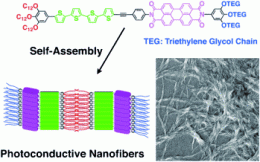Self-assembling devices: Design and synthesis of organic devices

(PhysOrg.com) -- Organic devices have greatly benefited from the remarkable advances in synthetic organic chemistry that have allowed for the synthesis of a wide variety of π-conjugated molecules with attractive electronic functions.
In Chemistry -- An Asian Journal, Wei-Shi Li, Takanori Fukushima, Takuzo Aida, and co-workers, based at the Shanghai Institute of Organic Chemistry (China), Riken (Saitama, Japan), and the Japan Science and Technology Agency (Tokyo) describe the rational design strategy using side-chain incompatibility of a covalently connected donor-acceptor (D-A) dyad to synthesize organic p/n heterojunctions with molecular-level precision.
Although organic devices can be easily designed, without proper molecular design that allows for long-range ordering of π-conjugated molecules, the resulting devices will rarely show the expected performances. Thin-film organic photovoltaic devices require electron-donor (D) and -acceptor (A) molecules to assemble homotropically to form a heterojunction. Additionally, to achieve a highly efficient photoinduced charge separation, the resultant p- and n-type semiconducting domains must be connected over a long distance. However, D and A components tend to assemble together by means of a charge-transfer (CT) interaction, unfavorable for photoelectric conversion.
Oligothiophene (OT) and perylenediimide (PDI) have been synthesized to form covalently linked D-A dyads, which bear at their termini either incompatible or compatible side chains. The dyads with the incompatible side chains intrinsically self-assemble into nanofibrous structures, whilst the dyad containing the compatible side chains resulted in ill-defined microfibers. Flash-photolysis time-resolved microwave conductivity measurements, in conjunction with transient absorption spectroscopy, clearly shows that the assembly with the incompatible side chains exhibits a much greater photoconducting output than that with compatible side chains.
This design strategy with "side-chain incompatibility" provides promise for the realization of p/n heterojunctions from covalently connected D-A dyads. Furthermore, this design strategy can give rise to long-range structural integrity that is essential for excellent device performances. Aida writes "elaboration of side-chain-incompatible D-A dyads in terms of absorption range and carrier transport properties is a subject worthy of further investigations for developing molecularly engineered photovoltaic devices."
More information: Takuzo Aida, Use of Side-Chain Incompatibility for Tailoring Long-Range p/n Heterojunctions: Photoconductive Nanofibers Formed by Self-Assembly of an Amphiphilic Donor-Acceptor Dyad Consisting of Oligothiophene and Perylenediimide, Chemistry - An Asian Journal, dx.doi.org/10.1002/asia.201000111
















